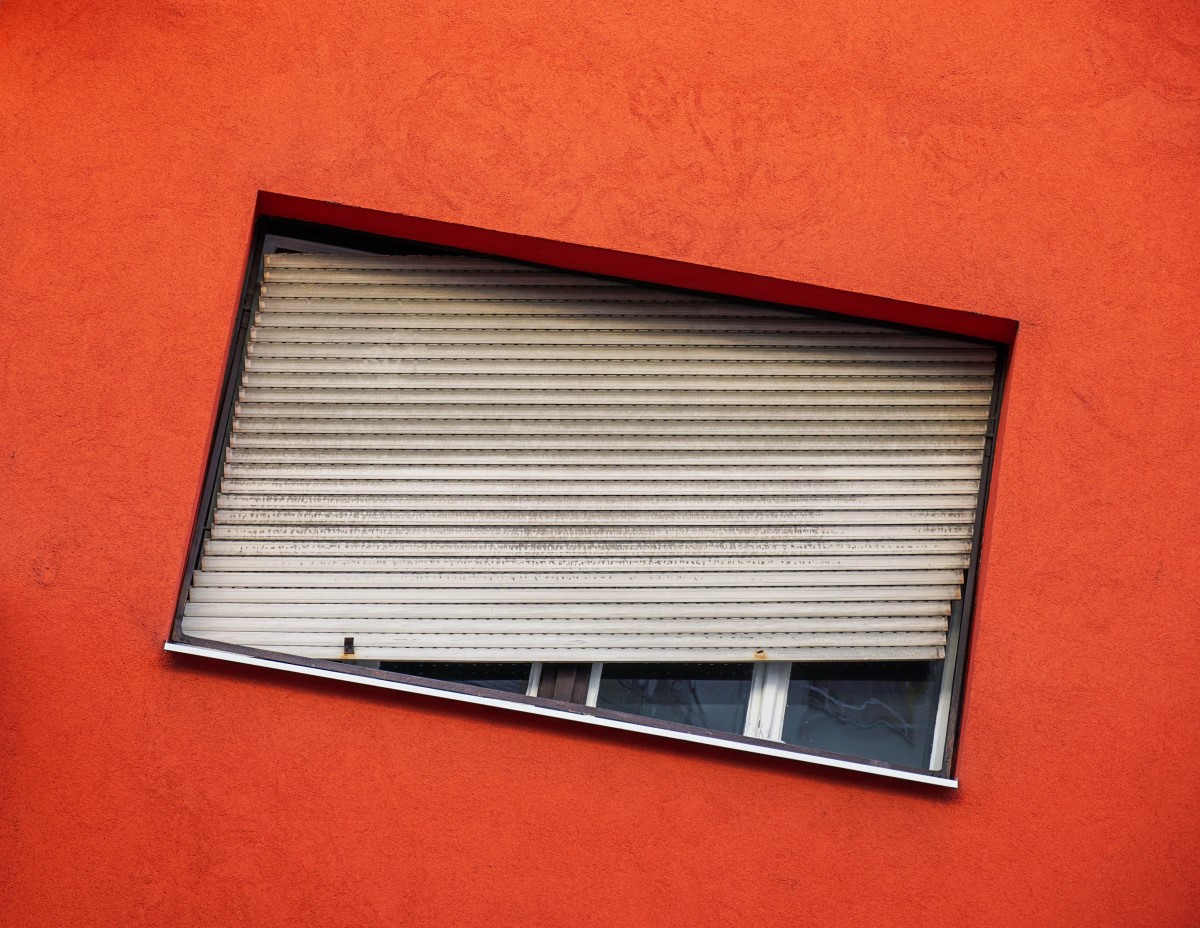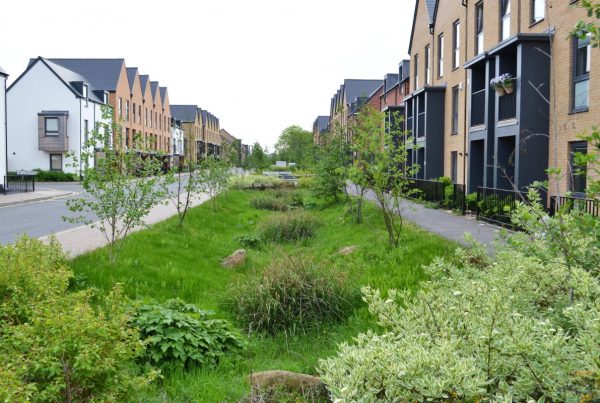ENERGY EFFICIENCY IN NUMBERS
Energy Cost Reduction Through Conscious Use
The recent sharp rise in energy prices hit the Hungarian people hard, which is not surprising after ten years of governmental utility cost reductions in Hungary. This change has drawn attention to energy efficiency issues more than ever before. For those who have limited background in energy efficiency, our article aims to introduce the principles of energy conscious building use and its possible payoffs.
Introduction
In Hungarian households, 71% of the overall energy consumption comes from heating. Together with hot water production, this amounts to 84% [1]. More than 40% of homes are heated with gas [2], so unsurprisingly, with the excessive rise in the gas prices, most people desperately started looking for solutions after the initial shock. Our first instinctive reaction is to invest in something new or buy new equipment to solve the problem. What should the alternative be to gas-heating? The cheaper electricity or the subsidized biomass? What are we better off with? A heat pump with solar panels, an electric water heater or a wood burning stove?
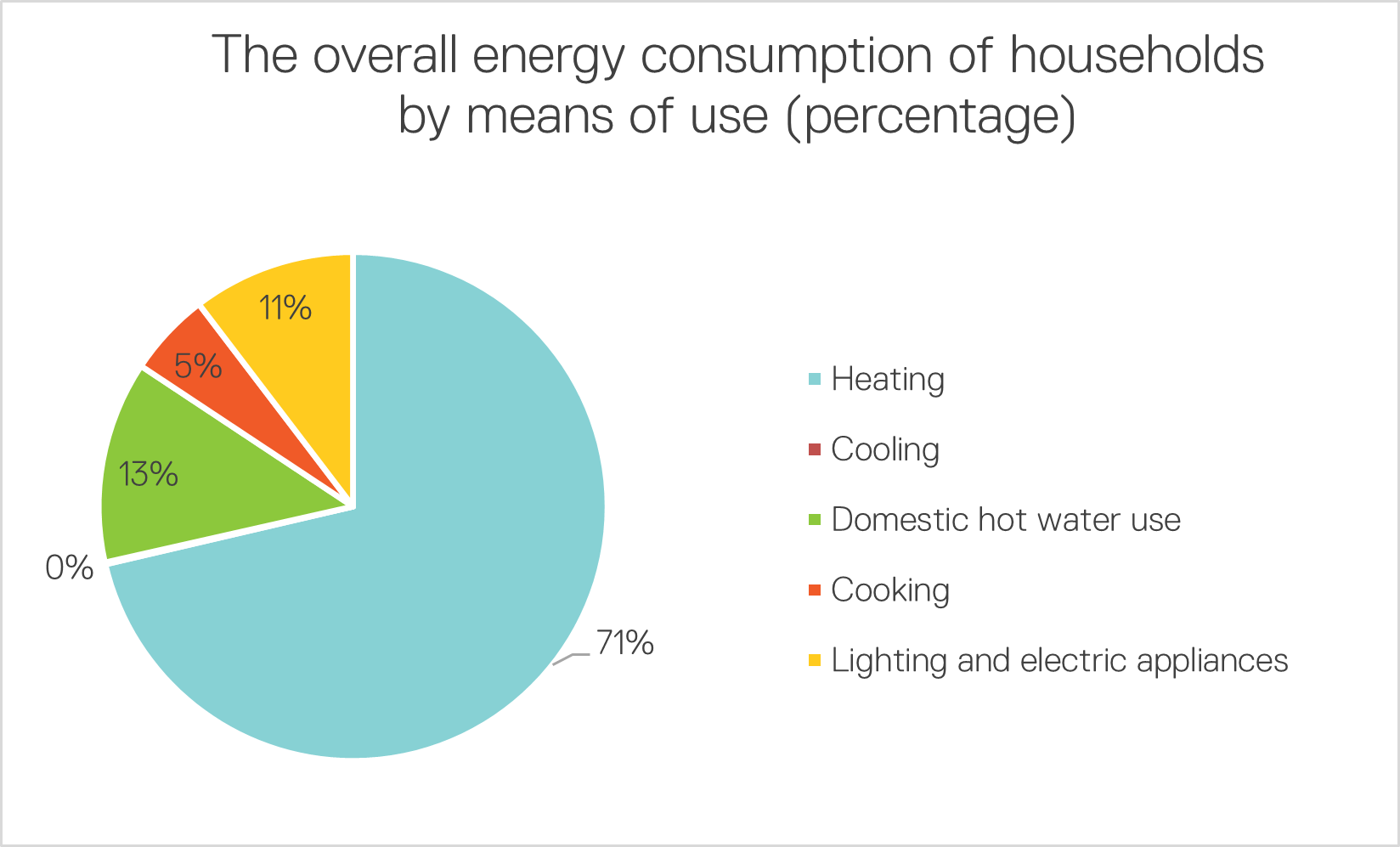

Figure 1: Overall energy consumption of households and distribution of heating by type. (Source: Hungarian Energy and Public Utility Regulatory Authority [MEKH], Hungarian Central Statistical Office [HCSO], 2020)
Yet the question of what we should heat with, – without optimising the building we live in and our behaviour as building users – is wrong.
The energy efficiency of Hungary’s domestic building stock is in a significantly worse condition compared to our European neighbours. It is no question that massive renovations are inevitable. But before we make any major investments, we should first consider whether our existing systems work as efficiently as expected, and whether we are getting the most out of them.
Warnings about the effects of climate change have been around in the news for decades, but now, the challenge of diminishing natural resources required to sustain our current way of life is also close-at-hand. Researchers and experts analysing the effects of the scarcity of elements foresee different scenarios for the future, but they all agree that without immediate action, society and civilization as we know is expected to change majorly during our lifetime. The question is whether this change can be kept under control by changing our habits voluntarily or we choose to wait and see the processes start on their own. Our response to the current energy crisis will be crucial in determining our ability to delay or positively influence the impacts of climate change. Therefore, the conscious use of energy becomes not only a strategy for saving money, but also one for long-term survival.
“Buildings don’t use energy, people do” – Kathryn B. Janda
We started researching the conscious use of buildings and occupant behaviour seven years ago with the aim to replace theoretical recommendations on optimising the energy consumption of buildings with solutions that are tailored to the building and its occupants. As we examined existing buildings, we found that their actual energy consumption could be much higher than predicted, and the difference might come from user behaviour.
When designing energy systems, energy demand calculations are based on standard data, where specific needs are not easy to take into account. Furthermore, standard design processes do not take into account how the building user, who is feeling discomfort, would act to restore their sense of comfort. Those occupants who are not well-acquainted with the principles of energy efficiency often react instinctively that leads to increased energy consumption, instead of finding other ways to alleviate their temporary discomfort (e.g., with drinking hot or cold drinks, changing their clothing, or exercising).
An example for irrational human behaviour can be illustrated by the use of the fan-coil equipment of an office building [3] we surveyed on a spring day. It was seen that some parts of the building were heated while other parts cooled at the same time, which could not be explained by objective considerations (e.g., glazing ratio or orientation). Employees used different modes of operation for the fan-coils even in similar, adjacent offices. In some cases, the rooms which were heated in the morning due to the cool morning weather were then cooled down in the afternoon during the higher outside temperatures and high incoming solar radiation, in some instances even to a temperature lower than the setpoint in the morning. The main reason for this is that users are more concerned with their momentary comfort and may not be aware of the operation of the energy systems around them, whereas with proper information, energy consumption could be tailored to their needs. By rectifying such anomalies alone, consumption could be reduced by up to 5-10% without any investments.
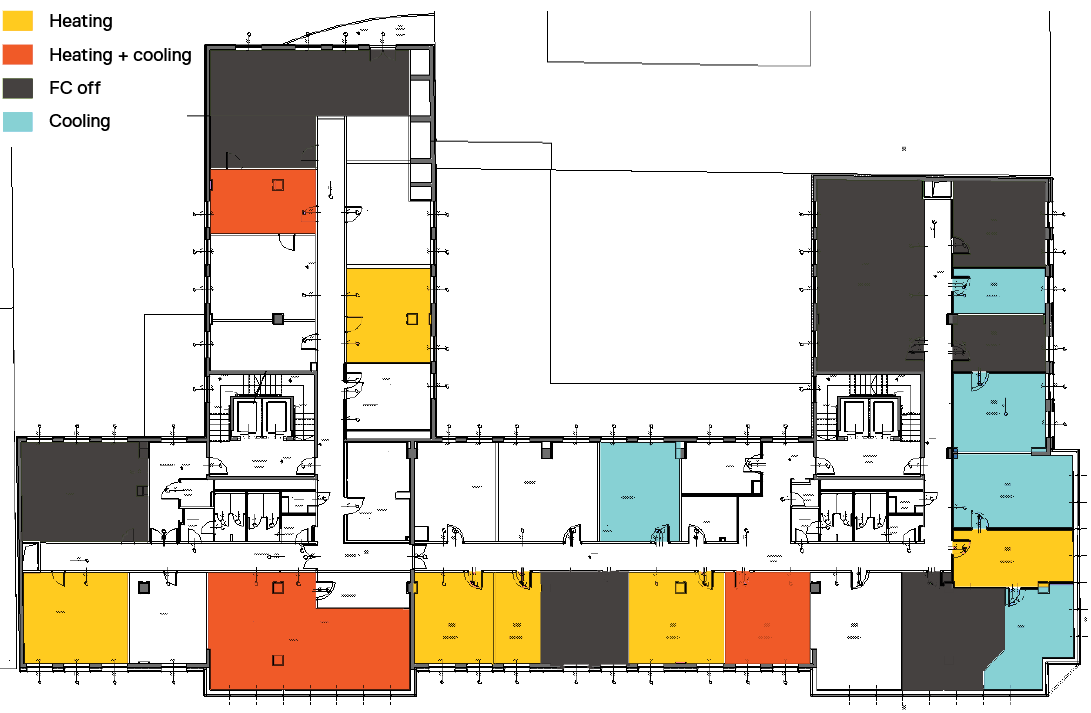
2/6 Figure 2: Anomalies in the heating and cooling of an office building on a spring day. (Source: ABUD)
Similar trends can be observed in case of flats and family homes, where users have direct influence on their thermal environment. Within the Enable research, building occupants were asked [4] about how they behave and what solutions they apply when feeling discomfortable in their own homes. Not surprisingly, when it was too hot at home in winter most people chose to remove clothing or turn down the heating. What is less justifiable from an energy point of view, however, is that the third most common reaction was to open a window, regardless of the heating being on. This kind of temperature control is common in buildings with centrally controlled district heating in Hungary, but the answer was also common in houses. Overheating, which can trigger unnecessary window opening, could be caused by several reasons. For example, if the heating is not controlled on the expected demand, e.g. not taking weather changes into account, but also due to heat-generating activities such as baking or vacuuming. Ventilation can also be the cause, when the cool breeze activates the thermostat, turning on the heating unnecessarily. Overheating in these cases can be avoided by temporarily overriding the setpoints. If the hot sensation is regular during the heating season, we should consider whether the heat dissipation is correctly balanced for each room. Design flaws might also cause such problems, but in all instances, the first step is to review the placement of the thermostat, the way the thermostatic valves are used and how the system is balanced hydraulically. In a building with central heating, if there is no balance between the heat demand and the heat supply, the underheated room’s demand will determine the heat supplied through the whole system, causing overheating in the other rooms.
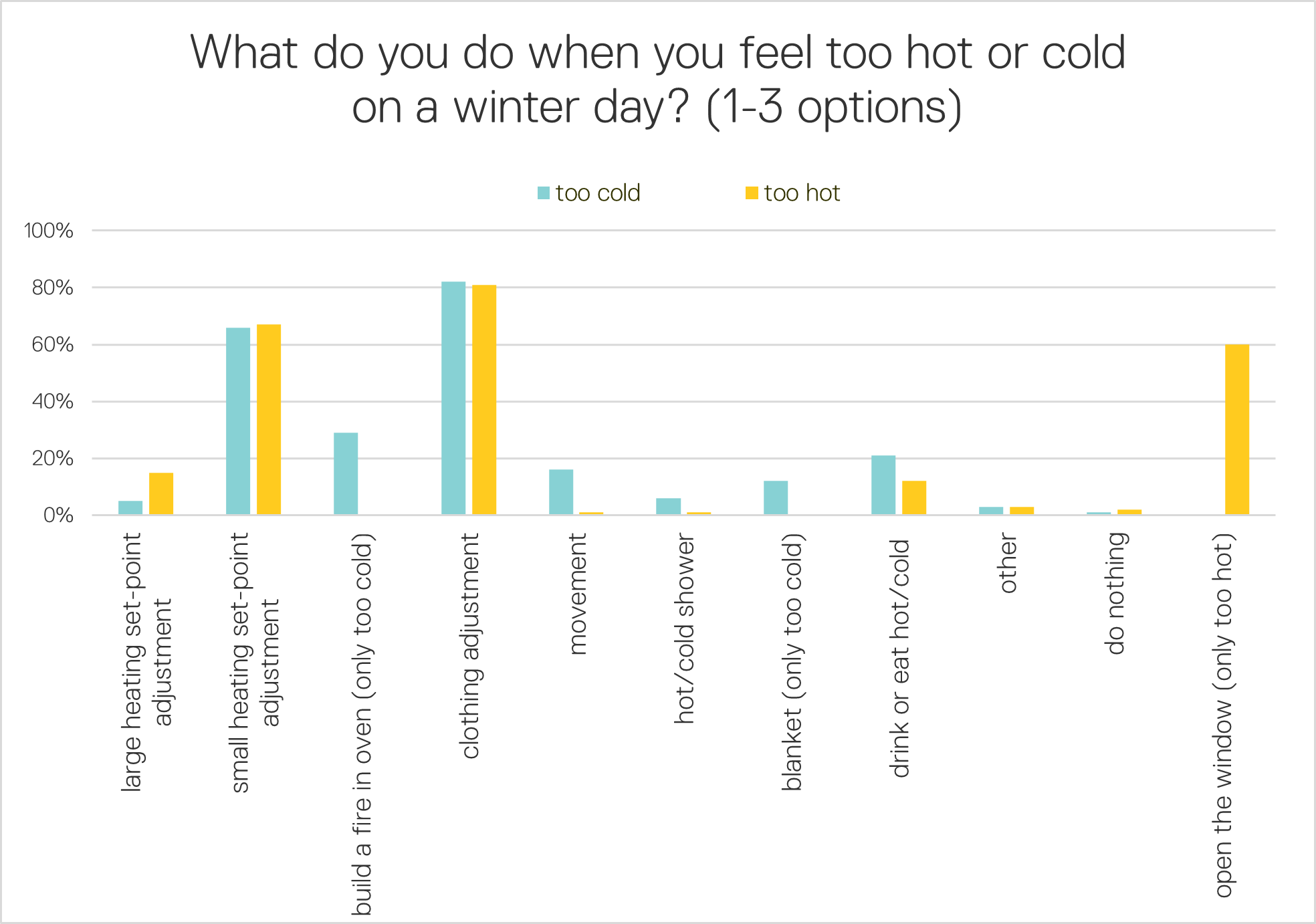
3/6 Figure 3: Human responses to easing discomfort in winter. (Source: ABUD based on Andersen [2009])
Talking about opening the window…
Glazed openings (doors, windows) and associated structures (typically roller blinds in case of family homes) play a prominent role in conserving heat and making use of passive radiative gains. These surfaces should be used in both heat-blocking and heat-utilizing modes throughout the year.
In either mode – following the principles of efficient ventilation – it is advisable to create short and intensive cross ventilation by fully opening the windows, instead of using tilted windows for long periods. This way only the heat content of used air is lost, but not the heat absorbed by the structures with high thermal capacity (walls, ceilings). Rather than relying on our subjective perception of temperature, it is recommended to measure indoor and outdoor temperature and humidity and assess the need for ventilation based on objective parameters.
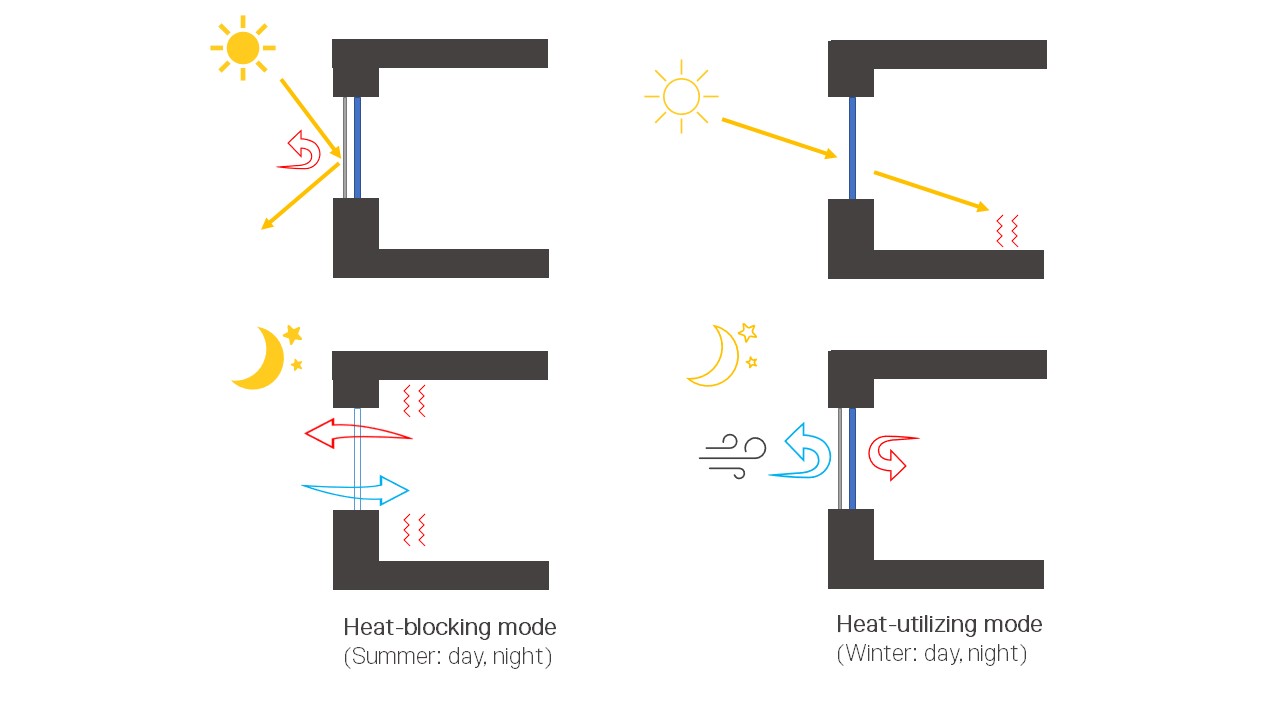
4/6 Figure 4: Operation modes of windows and associated structures. (Source: ABUD)
To delay the start of the heating period, it is advisable to start applying the heat-utilizing mode already at the beginning of autumn. In this case, the blinds should be fully opened during the day but lowered around sunset once the lights are switched on, to preserve the most heat. By shading the outer surface of windows, the radiative heat exchange between the glass and the cold sky is reduced as the closed blinds create a heat insulating air layer. The blinds should only be gradually raised after sunrise, depending on the building’s orientation. If the weather is windy or the sky is overcast, it is advisable to keep the blinds closed during the day too, if we are not at home anyway.
At the end of the heating season – following a short transition period – it’s a good idea to switch to heat-blocking mode: during the day, the blinds should be closed when sunlight is not needed, regardless of cardinal directions. While this is clear in case of direct sunshine, the sunshine coming from the North should also be filtered out to avoid overheating, as well as any diffuse solar radiation, since it has significant heat content. Therefore, the blinds should be raised just enough to let the necessary amount of natural light in. Additional to the rapid ventilations during the day, continuous night-time ventilation is also recommended and effective for most of the season. Combining it with shading can significantly reduce or even eliminate the need for air conditioning in houses.

5/6 Figure 5: Solar radiation per 1m2 of façade surface distributed by cardinal directions on a sunny day in July. (Source: ABUD – based on Meteonorm data)
The optimisation of heating temperature
In terms of energy efficiency, enormous potential lies in lowering the heating setpoint in buildings, not only individually but also on a national level. According to a survey about residential buildings in Hungary [5], 24% of respondents heat their buildings to a temperature above 24 °C, while another 41% set the temperatures between 22-24 °C. More than a quarter of those surveyed reported that they cannot control the temperatures in their homes, revealing shocking insights in terms of energy efficiency. More than 25% of the respondents keep a set temperature, while nearly 40% adjust it manually to suit their needs. Only 5% disclosed that they program the thermostat to different temperatures throughout the day.
As a rule of thumb, an average of “6% savings per degree Celsius” is commonly quoted. Even more savings can be achieved by lowering setpoints and adjusting our daily habits slightly by applying a setback in unoccupied periods and at night. Reducing the temperature from 22 °C to 20 °C alone can save 19% of energy for a family home according to our calculations. If we can settle for a daytime temperature of 22 °C and 20 °C during nights and absences, we could reduce heating energy demand by approximately half of that, which is 10%. If these setpoints are further reduced by 2 °C (20/18 °C), a total savings of about 20-25% could be achieved.
Lowering the temperatures abruptly might sound intimidating, but our bodies can gradually adapt if we wear appropriate clothing and actively move around regularly. When the building is only heated to comfort temperatures when it is necessary and applying setbacks for the rest of the time, our comfort levels would not be compromised while saving energy. It “merely” requires a higher awareness of using our buildings.
Increasing efficiency with maintenance
What we also can do without excess spending is to review the existing systems to see if they operate efficiently. Over time, our equipment usually performs below expected levels and maintenance is often not carried out due to the lack of time and/or expertise. In many cases, however, it would not be necessary to call an expert, since there are certain tasks that we can do on our own. For example, descaling an electric water heater is recommended at least every two years, as the efficiency can decrease by up to 30% [6]. For a family of four with a water heater using off-peak electricity this inefficiency generates an extra cost of approximately HUF 15 000 per year. Covering radiators with furniture and interior design elements could also reduce efficient heat transmission, as for radiators 20% of the heat is radiated and the remaining 80% is transmitted by convection, i.e., by air flow. Although we don’t usually think of it this way, cleaning our windows before winter also promotes energy efficiency, and if it’s only done once a year, it should be in the autumn rather than springtime. Dust on the window reduces the penetration of solar energy: calculating with 5% coverage, an average-size south-facing window wastes 25 kWh of energy, which costs approximately HUF 2 000 per window if we use gas heating. These are seemingly small interventions, but they also help to extend the lifetime of our equipment and thus improve energy efficiency.
Conclusion
In overall, while the energy performance of the domestic building stock is well behind European levels, we are still able to optimise the amount of energy needed to heat our buildings without major investments. Changing habits is not easy without sufficient motivation, however, with a little attention, many households could significantly reduce their energy consumption without having to make enormous sacrifices. The above principles should also be applied to low-energy flats and houses, to truly perform as low as intended. These principles are not only theory; practicing them in my own home, I’ve witnessed their efficiency myself. By temporarily accepting lower temperatures and maximizing solar gains, – that is, fine-tuning consumer habits – I have managed to delay the start of the heating season to 31st of October, which is more than two weeks later than the average date in previous years. The current energy crisis is a good test of our ability to voluntarily raise our energy awareness, which in turn serves the long-term liveability of our planet.
Author
Dr. Adrienn Gelesz PhD – Partner, ABUD – Advanced Building and Urban Design
References
[1] Based on 2020 MEKH data
[2] 2020 HCSO data
[3] Belafi, Zsofia, Tianzhen Hong, and Andras Reith. “Smart building management vs. intuitive human control—Lessons learnt from an office building in Hungary.” Building Simulation. Vol. 10. No. 6. Tsinghua University Press, 2017.
[4] Andersen, R. V. (2009). Occupant Behaviour with regard to Control of the Indoor Environment. Technical University of Denmark
[5] Enable projekt http://www.enable-eu.com/wp-content/uploads/2018/02/ENABLE.EU-D4.1.pdf
[6] https://hazesotthon.co.hu/tanacsadas/2017/01/10/a-bojler-a-vizko-es-a-magas-villanyszamla-osszefuggese.html
